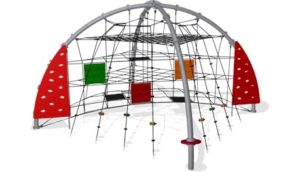A recent decision of the Federal Court considered the rights associated with a line of playground sculptures.
The Facts
The plaintiff specializes in the design, development, manufacturing, marketing, and branding of playground equipment. They developed a line of so called playground sculptures which included works entitled Performer Arch, Performer Dome and Explorer Dome. The plaintiff’s playground equipment was designed and built for the use of children on playgrounds and to be played with and climbed on etc. While the sculptures have aesthetic features they are also designed to be playful and safe, and are subject to technical safety requirements including requirements relating to arm reach and rope size.
The Performer Dome, which is representative of the plaintiff’s products, is shown below:

The defendant is an Ontario corporation which is a competitor of the plaintiff’s. The defendant received requests from its distributors for products similar to the plaintiff’s sculptures. As a result the defendant engineered a line of playground equipment that was designed to be the equivalent of the plaintiff’s sculptures.
The Action
The plaintiff claimed that the design of their playground sculptures was a distinguishing guise. In addition, it was alleged that the defendant directed attention to its products in such a way as to cause or to be likely to cause confusion between the two lines of playground structures. Finally, the plaintiff alleged that it was the owner of copyright relating to its playground sculptures and that the defendants infringed the copyright.
The defendant denied any responsibility and said that the plaintiff’s failure to seek protection under the Industrial Design Act was fatal to their case.
The Trademarks Act
The definition of a trademark under the Act includes a “distinguishing guise” which is defined as consisting of “a shaping of goods…the appearance of which is used by a person for the purposes for distinguishing goods manufactured, or sold by them from those manufactured, or sold, by others.”
The plaintiff alleged that the appearance of its playground structures was recognised by the public as having a particular source and that the visual external appearance and three dimensional shape of each of the sculptures, was a distinguishing guise.
Unfortunately, for the plaintiff the court found that the plaintiff had not presented sufficient evidence to show that the relevant market recognized the shape and appearance of its playground sculptures as having a single source or that the shape of the sculptures was used to market them. On the contrary the evidence seemed to indicate that the plaintiff used a traditional written trademark to indicate the source of its products to customers.
The judge observed that despite the connection with a product, a trademark must not be confused with the product. A trademark is something else, a symbol of connection between the source of the product and the product itself.
For the same reasons the plaintiff was unsuccessful in asserting a claim for passing off. In addition, the plaintiff was not in a position to show that there was any goodwill associated with its playground sculptures in Canada.
Copyright
The plaintiff established that it owned copyright in its sculptures and that the defendant had made reproductions of its playground sculptures that were prima facie infringing. The Copyright Act provides there is no liability for infringement where copyright subsists in a design applied to a useful article and with the authority of the copyright owner the article is reproduced in a quantity of more than 50. For the purposes of this provision a useful article is “an article that has a utilitarian function”. A “utilitarian function” means a function other than merely serving as a substrate or carrier for artistic or literary matter.
The plaintiff argued that its sculptures were not useful. However, it was evident to the court that they were since they were designed and built for use on children’s playgrounds, to be played with and climbed on.
It was not disputed that the plaintiff had authorized that more than the 50 reproductions of each of its playground sculptures be manufactured on a worldwide basis, which had occurred before the defendant copied the plaintiff’s sculptures. However, each of the plaintiff’s playground structures had not been reproduced more than 50 times in Canada when the defendant commenced selling and manufacturing the impugned products.
When the judge considered the wording of the relevant provision of the Copyright Act, she said it was clear that the section should be interpreted by reference to the actions of the parties on a worldwide basis. As a result, the plaintiff’s claim for copyright infringement was dismissed.
Industrial Designs
The Industrial Design Act applies to designs which means features of shape, configuration, pattern or ornament and any combination of those features that, in a finished Article, appeal to and are judged solely by the eye. A registration could likely have been obtained under the Act for the plaintiff’s sculptures. Unfortunately for the plaintiff, if a design has been published anywhere in the world more than 1 year prior to date of the application in Canada, a registration will be refused. In this case the plaintiff failed to obtain protection in Canada under the Industrial Design Act.
Comment
This situation in Canada as illustrated by this case is substantially different from that in the United Kingdom or in the European Union. In the U.K. and countries which are members of the EU it is possible to assert rights relating to a non-registered design right that protects the shape and configuration of the products in issue. The term of protection of the relevant rights in the U.K. and EU vary as does the term of protection for registered designs.
Frequently the failure to file a timely application for industrial design in Canada is a trap for the unwary. This is particularly so for businesses from the U.K. or the EU who may be relying on the non-registered design right. It would make sense for the Government to consider making a non-registered design right available in Canada.
John McKeown
Goldman Sloan Nash & Haber LLP
480 University Avenue, Suite 1600
Toronto, Ontario M5G 1V2
Direct Line: (416) 597-3371
Fax: (416) 597-3370
Email: mckeown@gsnh.com
These comments are of a general nature and not intended to provide legal advice as individual situations will differ and should be discussed with a lawyer.
